Arm Announces Mobile Armv9 CPU Microarchitectures: Cortex-X2, Cortex-A710 & Cortex-A510
by Andrei Frumusanu on May 25, 2021 9:00 AM EST- Posted in
- SoCs
- CPUs
- Arm
- Smartphones
- Mobile
- Cortex
- ARMv9
- Cortex-X2
- Cortex-A710
- Cortex-A510
New DSU-110 L3 & Cluster: Massively More Bandwidth
Alongside the new CPU microarchitectures, Arm today is also announcing a new L3 design in the form of the new DSU-110. The “DynamIQ Shared Unit” had been the company’s go-to cluster and “core complex” block ever since it was introduced in 2017 with the Cortex-A75 and Cortex-A55. While we’ve seen small iterative improvements, today’s DSU-110 marks a major change in how the DSU operates and how it promises to scale up in cache size and bandwidth.
The new DSU-110 is a ground-up redesign with an emphasis on more bandwidth and more power efficiency. It continues to be the core building block for all of Arm’s mobile and lower tier market segments.
A key metric is of course the increase of L3 cache configuration which will now go up to 16MB this generation. This is of course the high-end of the spectrum and generally we shouldn’t expect such a configuration in a mobile SoC soon, but Arm has had several slides depicting larger form-factor implementations using such a larger design housing up to 8 Cortex-X2 cores. This is undoubtedly extremely interesting for a higher-performance laptop use-case.
The bandwidth increase of the new design is also significant, and applies from single-thread to multi-threaded scenarios. The new DSU-110 promises aggregate bandwidth increases of up to 5x compared to the contemporary design. More interesting is the fact that it also significantly boosts single-core bandwidth, and Arm here actually notes that the new DSU can actually support more bandwidth than what’s actually capable of the new core microarchitectures for the time being.
Arm never really disclosed the internal topology of the previous generation DSU, but remarks that with the DSU-110 the company has shifted over to a bi-directional dual-ring transport topology, each with four ring-stops, and now supporting up to 8 cache slices. The dual-ring structure is used to reduce the latencies and hops between ring-stops and in shorten the paths between the cache slices and cores. Arm notes that they’ve tried to retain the same lower access latencies as on the current generation DSU (cache size increases aside), so we should be seeing very similar average latencies between the two generations.
Parallel access increases for bandwidth as well as more outstanding transactions seem to have been also very important in order to improve performance, which seems very exciting for upcoming SoC designs, but also puts into more question the previously presented CPU IPC improvements and exactly how much the new DSU-110 contributes to those numbers.
Architecturally, one important change to the capabilities of the DSU-110 is support for MTE tags, a upcoming security and debugging feature promising to greatly help with memory safety issues.
The new DSU can scale up to 4x AMBA CHI ports, meaning we’ll have up to 1024-bit total bi-directional bandwidth to the system memory. With a theoretical DSU clock of around 2GHz this would enable bandwidth of up to 256GB/s reads or writes, or double that when combined, plenty enough to be able to saturate also eventual high-end laptop configurations.
In terms of power efficiency, the new DSU offers more options for low-power operation when in idle situations, implementing partial L3 power-down, able to reduce leakage power of up to 75% compared to the current DSU.
In general idle situations but still having the full L3 powered on, the new design promises up to 25% reduction in leakage power all whilst offering 2x the bandwidth capabilities.
It’s important to note that we’re talking about leakage power here- active dynamic power is expected to generally scale linearly with the bandwidth increase of the new design, meaning 5x the bandwidth would also cost 5x the power. This would be an important factor to note into system power and in general the expected power behaviour of the next-gen SoCs when they’re put under heavy memory workloads.
Arm describes the DSU-110 as the backbone of the Armv9 cluster and that seemingly seems to be an apt description. The new bandwidth capabilities are sure to help out both with single-threaded, but also with multi-threaded performance of upcoming SoCs. Generally, the new 16MB L3 capability, while it’s possible somebody might do a high-end laptop SoC configuration, isn’t as exciting as the now finally expected move to a new 8MB L3 on mobile SoCs, hopefully also enabling higher power efficiency and more battery life for devices.


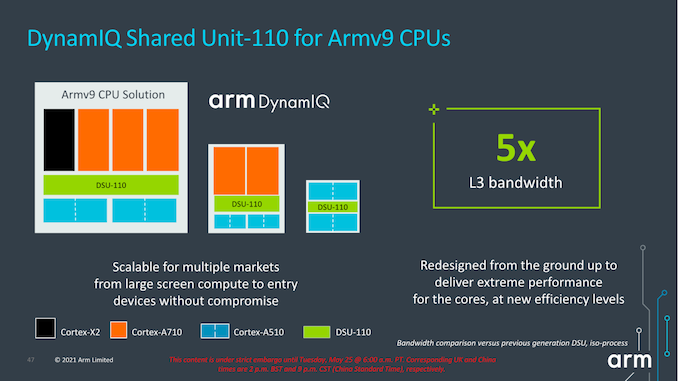
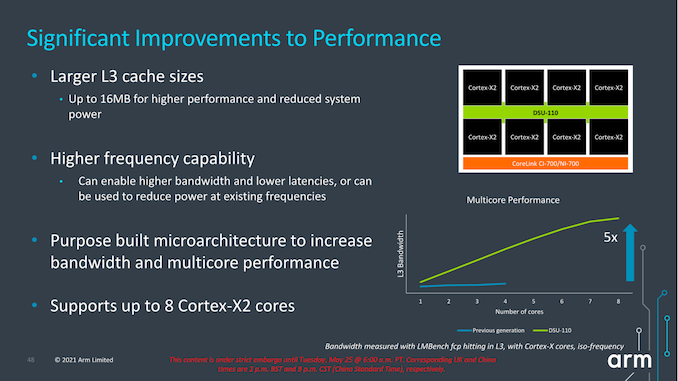
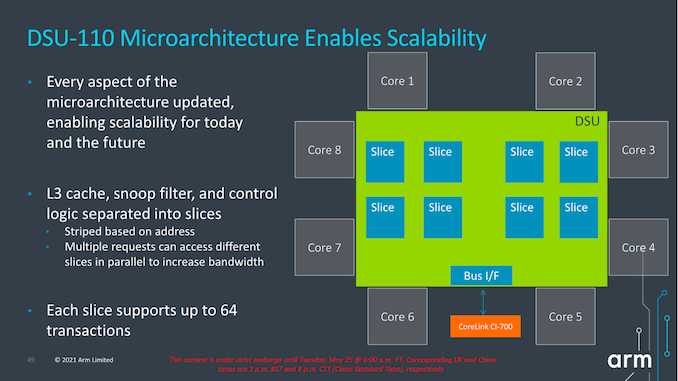
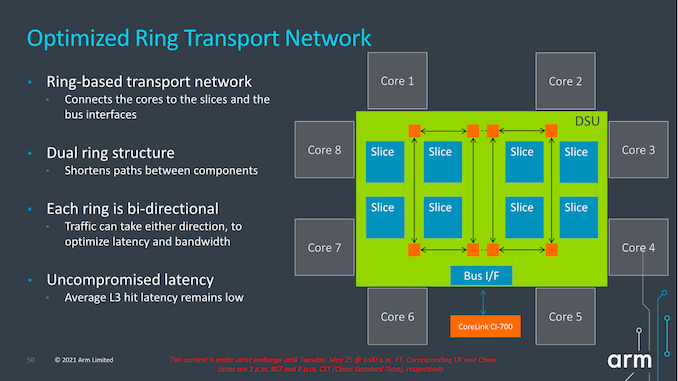
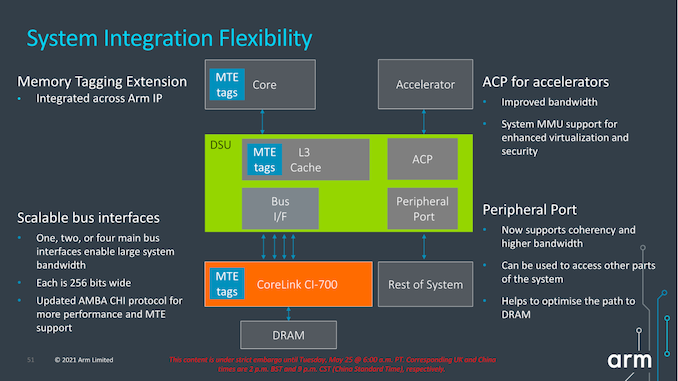

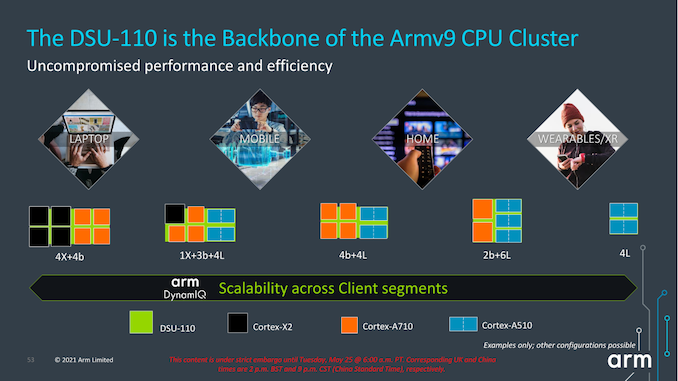








181 Comments
View All Comments
RSAUser - Wednesday, May 26, 2021 - link
Basically interesting for cases when you don't want to add an A73, e.g. It's pretty big news in the watch space where it's been the same 4/5yo architecture for a very long time.mode_13h - Thursday, May 27, 2021 - link
> It's pretty big news in the watch spaceI'm actually surprised people are even using A55s in smartwatches, or that ARM is targeting the A510 at them. I'd figured the most they could get away with would be the A35.
I guess pairing a couple A55s with some A35s might be a way to get responsiveness *and* battery life. Is that something people do?
mode_13h - Wednesday, May 26, 2021 - link
It'd be interesting to see how efficient the A73 would be, if you dropped its clock to match the A510's performance.AntonErtl - Thursday, May 27, 2021 - link
Yes. ARM gives some flowery wordings for the lower performance of the A510 compared to A73 (and Andrei reworded in the way ARM wants us to think: "very similar IPC and frequency capabilities whilst consuming a lot less power"; looking at the numbers given by ARM, the A510 has >20% less performance than the A73, at 35% less power. The DVFS stuff I have seen makes me expect that the A73 has the same or lower power at the same performance, if you lower the clock by 20% (or whatever the slowness factor of the A510 is).Andrei already showed us in his Exynos 9820 review that the A75 has better Perf and Perf/W for nearly all of the performance range of the A55. So I find it surprising that ARM went for another in-order design for the little core of ARMv9, instead of something like an ARMv9-enabled A75. For me it will certainly be an interesting microarchitecture to study, but I guess it will take some time until it appears in some Odroid or Raspi board.
mode_13h - Saturday, May 29, 2021 - link
> the A75 has better Perf and Perf/W for nearly all of the performance range of the A55.> So I find it surprising that ARM went for another in-order design for the little core of ARMv9
You're forgetting about PPA, though. The A510 is probably a lot smaller (ISO-process) than the A75.
> I guess it will take some time until it appears in some Odroid or Raspi board.
Look for A76-enabled SBCs late this year or early next. Rockchip's RK3588 will have 4x A76.
Raspberry Pi will probably be stuck on A72 or A73 for a couple more generations, since they plan to stay on 28 nm, for a while. Meanwhile, the Allwinner SoC in ODROID's N2 is made on 12 nm.
AntonErtl - Sunday, May 30, 2021 - link
Looking at the Exynos 9820 die shot, te A55 is ~3.4 times smaller than the A75, but it also has ~3.4 times lower top performance and a similar factor at the lowest common perf/W point, and from the looks of the line, in between. I doubt that the A510 is better in perf/area. But maybe it's the difference that ARM is claiming between the workloads Andrei used for evaluating performance (SPEC CPU2006) and what the A55 and A510 are doing in practice; if they mainly wait for peripherals, I can believe that their performance does not matter much.Thanks for the info on SBCs to be expected.
Wereweeb - Wednesday, May 26, 2021 - link
I'll ignore all the warfare in the comments, and just say this: imagine a 16-'core' A510 SoC. Sorry.mode_13h - Wednesday, May 26, 2021 - link
So, if you built a HPC CPU with A510 @ one core per complex, 2x 128-bit SVE2, and max L2 cache, how would area-efficiency (PPA) and power-efficiency (PPW) compare with a V1-based chip on the same node?Let's assume the workload has enough concurrency to scale up to all the A510 cores, and that there's enough ILP that the A510's lack of OoO isn't a significant impediment.
Shakal - Thursday, May 27, 2021 - link
Pardon my ignorance but what exactly is an "Alternate path predictor"? They mention that for the X2 core but I've not found any reference to what it is. I've heard of path based predictors but how does the alternate come into play?ballsystemlord - Friday, May 28, 2021 - link
Spelling and grammar errors (there are lots!):I read through everything but the conclusion.
"From a microarchitectural standpoint this is interesting as it means Arm will have been able to kick out some cruft in the design."
"has", not "have" and subtract "will":
"From a microarchitectural standpoint this is interesting as it means Arm has been able to kick out some cruft in the design."
"Even though it's a in-order core,..."
"an" not "a":
"Even though it's an in-order core,..."
"...and since then we haven't had seen any updates to Arm's little cores, to the point of it being seen as large weakness of last few generations of mobile SoCs."
You need an "a" and subtract "had":
"...and since then we haven't seen any updates to Arm's little cores, to the point of it being seen as a large weakness of last few generations of mobile SoCs."
"The new design if a clean-sheet microarchitecture from Arm's Cambridge team which the engineers had been working on the past 4 years, ..."
"is" not "if":
"The new design is a clean-sheet microarchitecture from Arm's Cambridge team which the engineers had been working on the past 4 years, ..."
"... the performance impact and deficit is said to only a few percent versus having a pipeline dedicated for each core."
Add a "be":
"... the performance impact and deficit is said to be only a few percent versus having a pipeline dedicated for each core."
"The dual-ring structure is used to reduce the latencies and hops between ring-stops and in shorten the paths between the cache slices and cores."
"to", not "in":
"The dual-ring structure is used to reduce the latencies and hops between ring-stops and to shorten the paths between the cache slices and cores."
"Architecturally, one important change to the capabilities of the DSU-110 is support for MTE tags, a upcoming security and debugging feature promising to greatly help with memory safety issues."
"an" not "a":
"Architecturally, one important change to the capabilities of the DSU-110 is support for MTE tags, an upcoming security and debugging feature promising to greatly help with memory safety issues."
"The SLC can server as both a bandwidth amplifier as well as reducing external memory/DRAM transactions, reducing system power reduction."
"serve", not "server" and "consumption", not "reduction":
"The SLC can serve as both a bandwidth amplifier as well as reducing external memory/DRAM transactions, reducing system power consumption."
"Overall, the new system IP announced today is very interesting, but the one question that's one has to ask oneself is exactly who these net interconnects are meant for."
Excess "'s". Refactoring makes more sense.
"Overall, the new system IP announced today is very interesting, but we have to ask who exactly these net interconnects are meant for."